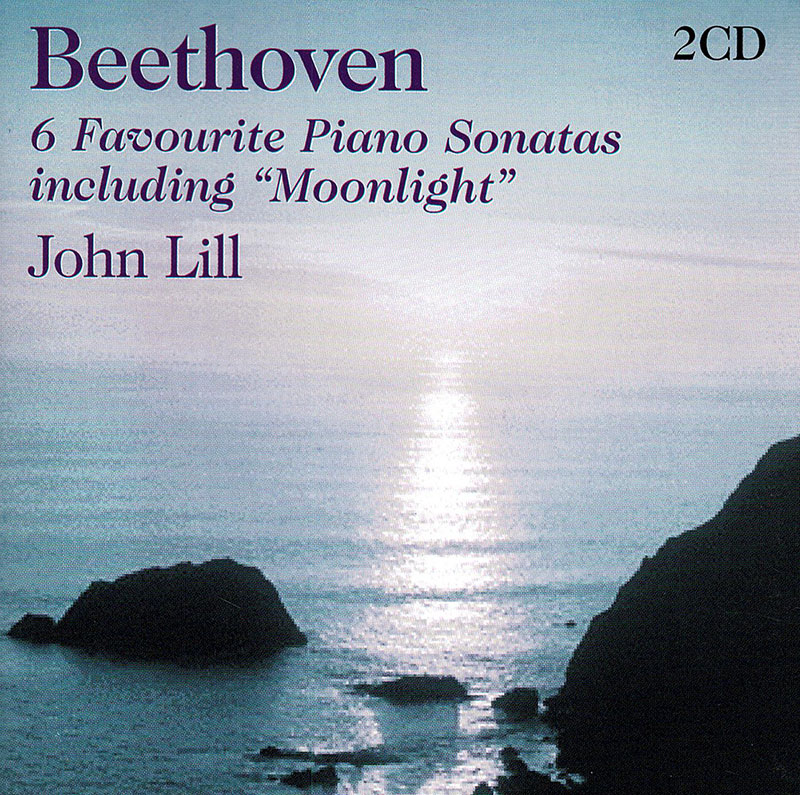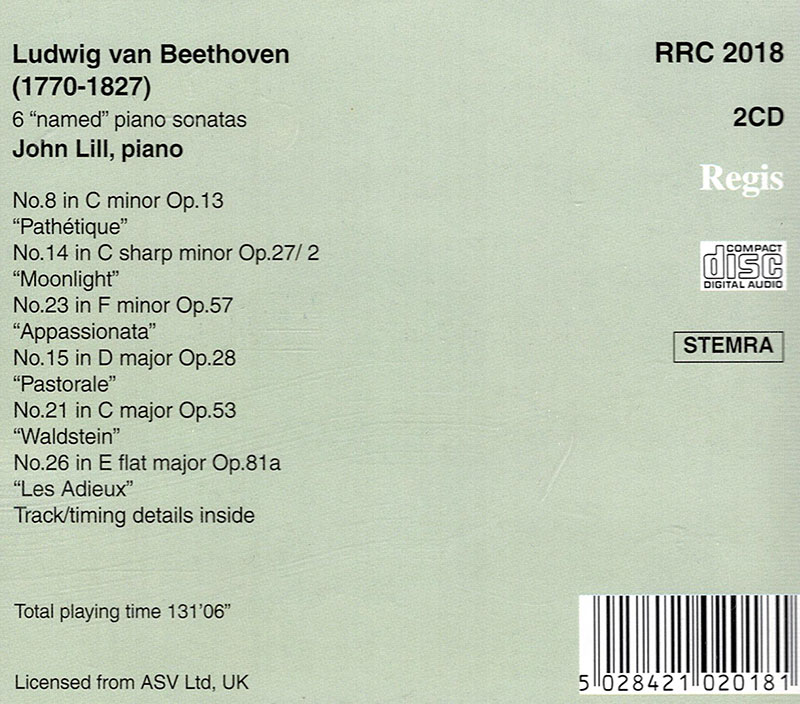Logowanie
Mikołaj - ten to ma gest!
Elton John, The Mamas & The Papas, Cat Stevens, Rod Stewart, Bobbie Gentry, Stevie Wonder, Engelbert Humperdinck
Memory Lane
Edycja Numerowana - 1000 egzemplarzy w skali światowej
RACHMANINOV, Eiji Oue, Minnesota Orchestra
Symphonic Dances / Vocalise
Best Recordings of 2001!!! NAJCZĘŚCIEJ KUPOWANA PŁYTA Z RR!
Karnawał czas zacząć!
Music of Love - Hi-Fi Latin Rhythms
Samba : Music of Celebration
AUDIOPHILE 24BIT RECORDING AND MASTERING
CHOPIN, LISZT, DEBUSSY, DVORAK, Gerhard Oppitz
Dances romantiques - A fantastic Notturno
Wzorcowa jakość audiofilska z Clearaudio
Winylowy niezbędnik
ClearAudio
Double Matrix Professional - Sonic
najbardziej inteligentna i skuteczna pralka do płyt winylowych wszelkiego typu - całkowicie automatyczna
John Lill
Six Favourite Piano Sonatas

- Beethoven: 6 Favourite Piano Sonatas "Pathetique" "Moonlight" "Pastorale" "Waldstein" "Appassionata" "Les Adieux"
- John Lill, Piano
- CD1
- No.8 in C minor Op. 13 "Pathetique"
- 1. Allegro di molto e con brio 9.11
- 2. Adagio cantabile 6.03
- 3. Rondo, allegro 4.54
- No. 14 in C sharp minor Op.27/ 2 "Moonlight"
- 4. Adagio sostenuto 6.49
- 5. Allegretto 2.18
- 6. Presto agitato 7.08
- No.23 in F minor Op.57 "Appassionata"
- 7. Allegro assai 10.42
- 8. Andante con molto 6.42
- 9. Allegro ma non troppo 7.55
- CD2
- No. 15 in D major Op.28 "Pastorale"
- 1. Allegro
- 2. Andante
- 3. Scherzo, allegro vivace
- 4. Rondo, allegro ma non troppo 4.59
- No.21 in C major Op.53 "Waldstein"
- 5. Allegro con brio 10.13
- 6. Introduzione, adagio molto 4.32
- 7. Rondo, allegretto moderato 6.41
- 8. Prestissimo 3.52
- No.26 in E flat major Op.81 a °Les Adieux"
- 9. Adagio- allegro 7.39
- 10. Andante espressivo 4.25
- 11. Vivacissimamente 5.40
- Total playing time 131'06"
- John Lill - piano
- BEETHOVEN
This collection includes most of the familiar piano sonatas from Beethoven's (1770-1827) early and middle periods. All have acquired nick-names which doubtless helps them to be identified but in fact only the earliest, known as the Pathetique, was so named by the composer. The Pathetique in C minor is commonly regarded as being the first modern sonata, a truly Sturm and Drang work in which the young rebel sets out his stall in the great opening chords. These chords are followed by long silences where one can imagine the composer listening to the effect this has on his audience. This is a movement crying out to be orchestrated. The second movement marked andante cantabile is renowned for the lyrical line, and was in fact turned into a pop song (!). If the first two movements are filled with pathos then the last movement lets us down to earth gently for it is a straightforward Rondo. The poet Rellstab gave the Moonlight its name (from an image of moonlight over Lake Lucerne) but again this seems only applicable to the first two movements. Comment has been made of the fact that Beethoven made a fair copy of the accompaniment to the Commendatore's death scene (Don Giovanni) alongside his sketch for the first movement and indeed both passages have an insistent triplet rhythm in common. The sonata was dedicated to Giulietta Guicciardi for whom the composer was carrying a torch at the time. This graceful lady can be heard in the second movement. The finale is full of stormy arpeggios and dramatic flashes. The editor of the English edition came up with the sobriquet Pastoral for the D major sonata which closes Beethoven's early period and certainly there is a rustic feel to the outer movements and the scherzo. The lovely Andante was, according to Czerny, Beethoven's favourite and looks ahead to Schubert. The Op 53 sonata in C major, dedicated to Count Waldstein, followed the Eroica symphony and admirably complements that great work with new feelings of spaciousness and intensity. Originally Beethoven planned the Andante favori for his slow movement but decided instead to publish this work separately. The Waldstein Sonata enabled Beethoven to explore the full compass of the piano at that time as its composition date (1803 - 4) coincided with his acquisition of the latest model. This was a spectacularly fertile period producing not only the Eroica but the Symphony No 4, the Piano Concerto No 4, the Appassionata Sonata, the Rasumovsky Quartets and the Violin Concerto in rapid succession. The Appassionata Sonata in F minor was given that name by the work's publisher Cranz, and it seems a wholly appropriate title as the Sonata is tempestuous and compassionate in fairly equal measure. The dark, mysterious opening discovers some repose in Db but travels back to its home key through some extraordinary progressions in the bass leading to a period of crisis that utilises the Fate motif rhythm - the three short beats followed by one long beat familiar from Symphony No 5. With this shuddering movement we have been transported headlong into the Romantic Age. The second movement is a solemn set of variations that seem to bring us to the brink of a terrible discovery with that diminished seventh, a favoured device of Weber when one is tempted to look behind that forbidden curtain. The violent finale follows without a break, full of sudden dynamic markings. The final Sonata, Les Adieux, in this set was written on the occasion of Archduke Rudolf's strategic domestic withdrawal from Vienna to Budapest in the wake of Napoleon's advance. Each movement is given a heading: Farewell, Absence, Return, and as such the mood of the music is typical of its period. Much of it, especially the final movement which resembles the Emperor Concerto, is self-explanatory. Les Adieux was to be his last piano sonata for five years. By the time of his return to the genre his style would be quite different, altogether more introspective. The pianist on these recordings John Lill made his mark early. At the age of nine he gave his first recital; at eighteen he performed Rachmaninov's Third Concerto under Boult and for his triumphant London debut at twenty he played the Emperor. He won the coveted Moscow International Tchaikovsky Competition in 1970 that inevitably led to engagements all over the world performing at leading venues as a recitalist and with many famous orchestras and conductors. His repertoire, much of which he has recorded, consists of over seventy concertos and he is particularly renowned for his Beethoven interpretations. In 1978 he was awarded the OBE for his services to music. ©James Murray 2000





























